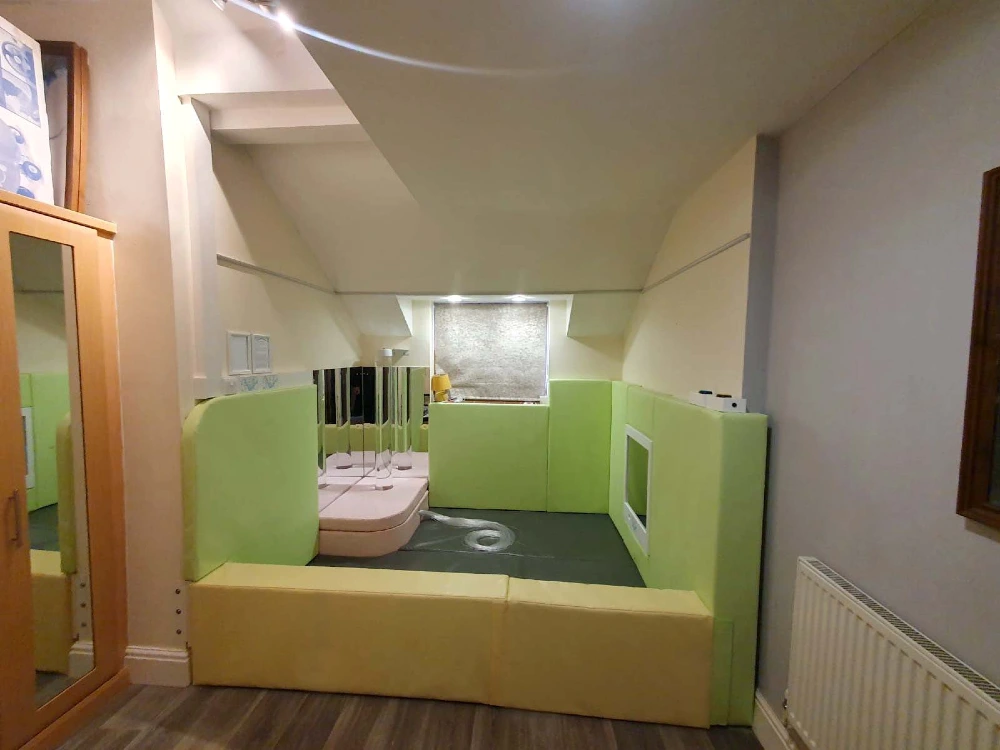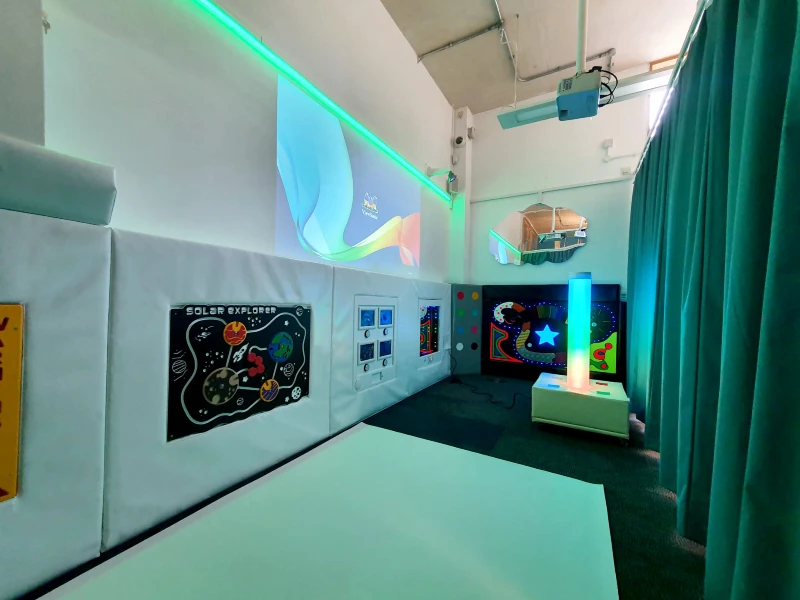Creating a sensory space doesn’t have to be an expensive or overwhelming task. With a little creativity and thoughtful planning, it’s possible to design an engaging and effective sensory environment that works within your budget.
Whether it’s for a school, healthcare setting, or home, sensory spaces can be tailored to suit any need without breaking the bank. Here are some practical tips to help you create a sensory space on any budget.
Start with a Clear Plan
Before diving into purchases, take a moment to plan your sensory space. Think about the purpose of the room and the specific needs of the people who will use it. Ask yourself:
- What kind of sensory input is most important? (e.g., visual, tactile, auditory, olfactory)
- How much space do you have to work with?
- Are there any existing items that can be repurposed?
Having a clear plan will help you prioritise what you truly need, ensuring that your budget is spent wisely.
Focus on Multi-Use Items
Investing in multi-functional equipment is a smart way to maximise the potential of your sensory space while staying within budget. For instance, a bean bag chair, which typically costs around £20-£50, can serve multiple purposes—it provides a comfortable seating option for relaxation and also offers calming tactile input, making it an excellent choice for both children and adults.
Similarly, LED light strips, available for as little as £10-£20 online, are a versatile addition. They can create a soothing atmosphere with dim lighting or be adjusted to provide vibrant colours for visual stimulation, making them suitable for different moods and activities. You can find affordable LED light strips on platforms like Amazon or specialist sensory retailers.
Mirrors are another cost-effective option. Small acrylic safety mirrors, priced around £15-£25, not only enhance the light in the room, creating a brighter and more spacious feel but also provide visual stimulation as users interact with their reflections.
By choosing items that serve more than one function, you can reduce the need for additional purchases while ensuring the space remains engaging and adaptable for various sensory needs.
DIY Sensory Tools
Creating your own sensory tools is an excellent way to stretch your budget. With a few simple materials, you can make engaging and effective sensory items, such as:
- Sensory bottles: Fill clear plastic bottles with water, glitter, and small beads to create a calming visual effect.
- Tactile boards: Attach different textures, like sandpaper, fabric, or bubble wrap, to a wooden board for a hands-on sensory experience.
- Weighted lap pads: Sew small pouches filled with rice or dried beans to create comforting, weighted items.
These DIY options are cost-effective and can be customised to fit specific preferences or needs.
Use Everyday Items
Sometimes, the best sensory tools are already in your home or classroom. Everyday items can provide valuable sensory input without requiring additional spending. For example:
- String lights or fairy lights, available for £5-£10, create a soothing visual ambience.
- Baking trays filled with rice or beans, which cost only a few pounds for the materials, can serve as sensory bins.
- Pillows and blankets offer tactile comfort and can be used for relaxation zones.
- Bubble wrap is often free from packaging materials, this is a simple and engaging tool for tactile and auditory stimulation.
- Scarves or fabric swatches are affordable options, starting from £2 each, and are great for creating sensory games involving touch or movement.
- Plastic cups and spoons use these kitchen staples, costing less than £5, for sound play or to encourage fine motor skills with scooping and stacking activities.
- Crumpled aluminium foil, costing under £1 per roll, can provide a unique tactile and auditory experience.
- Zippered freezer bags are available for around £3 per pack, fill them with water, glitter, or small beads to create DIY squishy sensory bags.
- Cardboard boxes, free and highly versatile, can be transformed into tunnels, sensory forts, or textured surfaces for exploration.
Get creative and think outside the box when looking for materials to incorporate into your sensory space.
Create Zones Within the Space
Dividing the room into different zones can make the space feel more organised and purposeful. Focus on creating:
- A calming zone: Use soft lighting, comfortable seating, and gentle sounds to create a calm & relaxing atmosphere.
- An active zone: Include items like balance boards, foam blocks, or tactile pathways for movement and exploration.
- A sensory stimulation zone: Feature visually stimulating items like bubble tubes or fibre optics.
Organising the space into zones ensures that users can engage in different types of sensory activities without feeling overwhelmed.
Prioritise Lighting
Lighting plays a crucial role in any sensory space, and it doesn’t have to be expensive. Here are some budget-friendly lighting options:
- Battery-operated LED lights are portable and versatile.
- Lava lamps provide a soothing glow and visual interest.
- Colour-changing light bulbs can be used in standard lamps to create dynamic effects.
Lighting sets the tone for the space and can be easily adjusted to match different moods or needs.
Incorporate Nature
Bringing elements of nature into your sensory space can be both cost-effective and therapeutic. Consider adding:
- Plants: Real or artificial plants create a calming atmosphere and add a touch of greenery.
- Natural textures: Include materials like wood, stone, or bamboo for tactile and visual interest.
- Sounds of nature: Use sound machines or smartphone apps to play calming nature sounds, such as rain or birdsong.
Nature-inspired elements can help users feel grounded and connected to the world around them.
Shop Second-Hand or Look for Deals
To save money, explore second-hand stores, online marketplaces like eBay or Facebook Marketplace, or clearance sales. Many sensory-friendly items, like soft furnishings or lighting, can be found at a fraction of the cost. Keep an eye out for:
- Discounted sensory equipment from specialised retailers like Sensory Direct or Rompa, where you might find items like tactile mats starting at £10.
- Repurposed items that can serve sensory functions, such as exercise balls, are often available for under £15 in second-hand shops.
- Community groups or charities that may offer free or low-cost resources for schools or community projects.
Shopping second-hand not only helps your budget but is also an eco-friendly way to furnish your sensory space.
Ask for Donations
If you’re creating a sensory space for a school or community centre, consider reaching out to local businesses or organisations for donations. Many companies are willing to donate materials, equipment, or funding for projects that benefit the community. You could also organise a fundraiser or crowd-funding campaign to support your efforts.
Keep It Flexible
A sensory space doesn’t need to be perfect from the start. Focus on creating a functional base and allow the room to evolve over time. Add new elements as your budget allows and as you better understand the needs of the users. Flexibility ensures the space remains dynamic and adaptable.
Designing a sensory space on a budget is all about creativity, resourcefulness, and planning. By focusing on multi-use items, DIY projects, and budget-friendly alternatives, you can create an environment that provides comfort, stimulation, and engagement for users of all ages.
Remember, a sensory space doesn’t have to be expensive to be effective—it’s the thought and intention behind the design that truly makes a difference.




